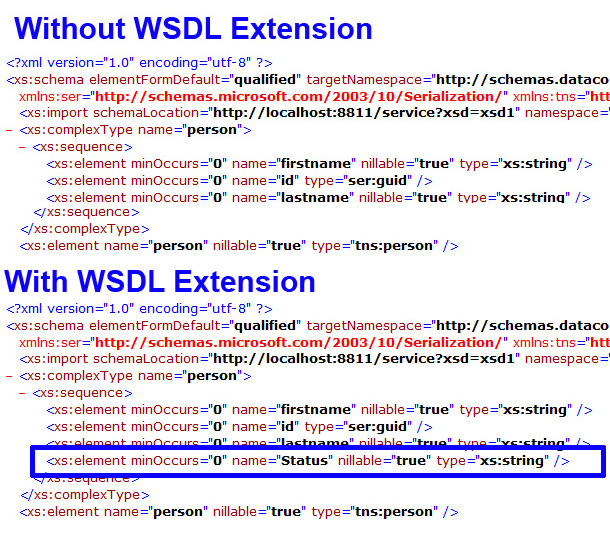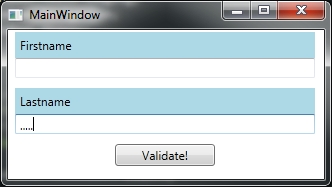With DataTables you have the ability to set a Error Message per Row. This is useful, when you want to display i.e. the Validation Errors in the GUI.
In a 3-Tier Application your client communicates with the Application Server via Services. Exchanging DataTables in a .NET Application works well. But if your services are used in a heterogeneous environment (i.e. Java or PHP Clients) you will not use DataTables.
.NET supports since version 4.0 POCO Entities. After adding a Entity Model (*.edmx) you can add a T4 Code Generation (*.tt) File, which defines the Template for your POCOs.
OK. We know POCO Objects are compatible with other Languages like Java. But you don’t have the possibility to set a Error Message (like in DataTable). You can extend your Entities with a additional Property… or defining a base Class and so on…
But there is a other way, when you want to keep your Entities clean.
If you need the Error Message only for Client-side work you can develop a WCF extension.
This extension extends your SOAP response with a Status Element. On the server-side you have your clean POCOs and on the client-side the POCOs will have an additional Property called “Status”.
Simple overview:

How it works:
Step 1.
Most clients generate a Service Proxy with the help of the WSDL file. That means, you have to add your Status Field in the WSDL XML. Otherwise your client POCOs won’t have a Status Property.
This is possible with WCF WSDL Interception.
Implement the
public class WsdlStatusExporter : IWsdlExportExtension, IEndpointBehavior
{
public void ExportContract(WsdlExporter exporter,
WsdlContractConversionContext context)
{ }
public void ExportEndpoint(WsdlExporter exporter,
WsdlEndpointConversionContext context)
{
// Get schemas
IEnumerator en = exporter.GeneratedXmlSchemas.Schemas().GetEnumerator();
while (en.MoveNext())
{
XmlSchema schema = (XmlSchema)en.Current;
foreach (XmlSchemaObject obj in schema.Items)
{
// POCOs are ComplexTypes
if (obj is XmlSchemaComplexType)
{
// Add Status Element
var complex = (XmlSchemaComplexType)obj;
var status = new XmlSchemaElement()
{
Name = "Status",
MinOccurs = 0,
IsNillable = true
};
// OK. This code here is ugly. I copied the SchemaType of my first Element. (Type is string)...
status.SchemaTypeName = ((XmlSchemaElement)
((XmlSchemaSequence)complex.Particle).Items[0]).SchemaTypeName;
// Add the new elemnt
((XmlSchemaSequence)complex.Particle).Items.Add(status);
}
}
}
}
public void AddBindingParameters(ServiceEndpoint endpoint,
BindingParameterCollection bindingParameters)
{ }
public void ApplyClientBehavior(ServiceEndpoint endpoint,
ClientRuntime clientRuntime)
{ }
public void ApplyDispatchBehavior(ServiceEndpoint endpoint,
EndpointDispatcher endpointDispatcher)
{ }
public void Validate(ServiceEndpoint endpoint)
{ }
}
Your WSDL Exporter Class must be added to the Behaviors List of your Endpoint.
Here a example of my WSDL.

Step 2.
Now your client POCOs have a Status Property. In Step 2, you have to inject the Status Message in the Soap Response.
Now you have to write and register a Message Interceptor.
Implement the
In
public class StatusInterceptor : IDispatchMessageInspector
{
private string StatusMessage { get; set; }
public object AfterReceiveRequest(ref Message request, IClientChannel channel,
InstanceContext instanceContext)
{
// This Actions fills the private string "StatusMessage"
Action messageSetter = status => { this.StatusMessage = status; };
messageSetter(string.Empty);
// Pass the Action to the Service Instance
((IStatus)instanceContext.GetServiceInstance()).SetStatus = messageSetter;
return null;
}
public void BeforeSendReply(ref Message reply, object correlationState)
{
var doc = new XmlDocument();
doc.Load(reply.GetReaderAtBodyContents());
// ...Response / ...Result
var child = doc.ChildNodes[0].ChildNodes[0];
// I used the default schema namespace
var statusEle = doc.CreateElement("a", "Status", "http://schemas.datacontract.org/2004/07/Service");
// Add Status Element
statusEle.InnerText = this.StatusMessage;
doc.ChildNodes[0].ChildNodes[0].AppendChild(statusEle);
// Write to new Message and replace the old one
var reader = new XmlNodeReader(doc.DocumentElement);
var msg = Message.CreateMessage(reply.Version, null, reader);
msg.Headers.CopyHeadersFrom(reply);
msg.Properties.CopyProperties(reply.Properties);
reply.Close();
reply = msg;
}
}
Now create a Attribute in which you register the Interceptor.
[AttributeUsage(AttributeTargets.Class)]
public class RegistrationBehavior : Attribute, IServiceBehavior
{
public void AddBindingParameters(ServiceDescription serviceDescription,
ServiceHostBase serviceHostBase, Collection endpoints,
BindingParameterCollection bindingParameters)
{ }
public void ApplyDispatchBehavior(ServiceDescription serviceDescription,
ServiceHostBase serviceHostBase)
{
for (int x = 0; x < serviceHostBase.ChannelDispatchers.Count; x++)
{
// Register the StatusInterceptor
var disp = (ChannelDispatcher)serviceHostBase.ChannelDispatchers[x];
if (disp != null)
foreach (EndpointDispatcher end in disp.Endpoints)
end.DispatchRuntime.MessageInspectors.Add(new StatusInterceptor());
}
}
public void Validate(ServiceDescription serviceDescription, ServiceHostBase serviceHostBase)
{ }
}
Step 3.
Now write your service. And don't forget to add the above written Attribute to the Service class.
The Service implements beside the
The
public interface IStatus
{
Action SetStatus { get; set; }
}
[ServiceContract]
public interface IService
{
[OperationContract]
person CheckPerson(person pers);
}
// Attribute!!
[RegistrationBehavior]
public class Service : IService, IStatus
{
public person CheckPerson(person pers)
{
// Your business logic
if (pers.firstname.Length == 0)
{
// Set the status (error)
this.SetStatus("Firstname is empty. Sorry : )");
}
else
{
// Set the status (info)
this.SetStatus("Firstname filled!");
}
return pers;
}
public Action SetStatus
{
get;
set;
}
}
Step 4.
GREAT! 🙂
Now host your Service. Here an example of a self-hosted Service with Extension.
static void Main(string[] args)
{
var address = new Uri("http://localhost:8811/service");
var host = new ServiceHost(typeof(Service), address);
var binding = new BasicHttpBinding();
var endpoint = host.AddServiceEndpoint(typeof(IService), binding, address);
// Ad the WSDL extension
endpoint.Behaviors.Add(new WsdlStatusExporter());
host.Description.Behaviors.Add(new ServiceMetadataBehavior() { HttpGetEnabled = true });
host.Open();
Console.WriteLine("OK! I'm ready!");
Console.ReadLine();
host.Close();
}
Now test the Extension.
I created a WPF client Application and generated the Service Proxy.
As you see, your

That means. Your WSDL generation works!
Now check if the SOAP Extension works.

When I press the Validate button, the client sends a Request to the Service. The Service will check the
After receiving the Response, the client will show the Status in a MessageBox.
(Here the code. Otherwise you won't believe me 🙂 )
public MainWindow()
{
InitializeComponent();
this.client = new srv.ServiceClient();
this.DataContext = new srv.person()
{
firstname = "",
lastname = "....."
};
}
private void Button_Click(object sender, RoutedEventArgs e)
{
var result = this.client.CheckPerson(new srv.person()
{
firstname = this.Firstname.Text,
lastname = this.Lastname.Text
});
MessageBox.Show(result.Status, "Validation Message",
MessageBoxButton.OK, MessageBoxImage.Exclamation);
}
Here the result (when

Seems to work! 😉